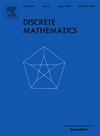Rainbow directed version of Dirac's theorem
IF 0.7
3区 数学
Q2 MATHEMATICS
引用次数: 0
Abstract
Let be a collection of not necessarily distinct graphs on the same vertex set V. A graph H is called rainbow in if any two edges of H belong to different graphs of . In 2020, Joos and Kim proved a rainbow version of Dirac's theorem. In this paper, we prove a rainbow directed version of Dirac's theorem asymptotically: For each , there exists an integer N such that when the following holds. Let be a collection of n-vertex digraphs on the same vertex set V. If both the out-degree and the in-degree of v are at least for each vertex and each integer , then contains a rainbow Hamiltonian cycle. Furthermore, we provide a sufficient condition for the existence of arbitrary rainbow tournaments in a collection of n-vertex digraphs, where a tournament is an oriented graph of a complete graph.
狄拉克定理的彩虹定向版本
设G={Gi:i∈[s]}是同一顶点集v上不一定不同的图的集合,如果H的任意两条边属于G的不同图,则G中的图H称为彩虹。2020年,Joos和Kim证明了Dirac定理的彩虹版本。本文渐近证明了Dirac定理的一个彩虹有向版本:对于每一个0<;ε<1,存在一个整数N,使得当N≥N时成立。设D={Di:i∈[n]}是同一顶点集合v上的n个顶点有向图的集合。如果对于每个顶点v∈v且每个整数i∈[n], v的出度和入度都至少为(12+ε)n,则D包含一个彩虹哈密顿循环。进一步,我们提供了n顶点有向图集合中任意彩虹比赛存在的充分条件,其中比赛是完全图的有向图。
本文章由计算机程序翻译,如有差异,请以英文原文为准。
求助全文
约1分钟内获得全文
求助全文
来源期刊

Discrete Mathematics
数学-数学
CiteScore
1.50
自引率
12.50%
发文量
424
审稿时长
6 months
期刊介绍:
Discrete Mathematics provides a common forum for significant research in many areas of discrete mathematics and combinatorics. Among the fields covered by Discrete Mathematics are graph and hypergraph theory, enumeration, coding theory, block designs, the combinatorics of partially ordered sets, extremal set theory, matroid theory, algebraic combinatorics, discrete geometry, matrices, and discrete probability theory.
Items in the journal include research articles (Contributions or Notes, depending on length) and survey/expository articles (Perspectives). Efforts are made to process the submission of Notes (short articles) quickly. The Perspectives section features expository articles accessible to a broad audience that cast new light or present unifying points of view on well-known or insufficiently-known topics.
 求助内容:
求助内容: 应助结果提醒方式:
应助结果提醒方式:


